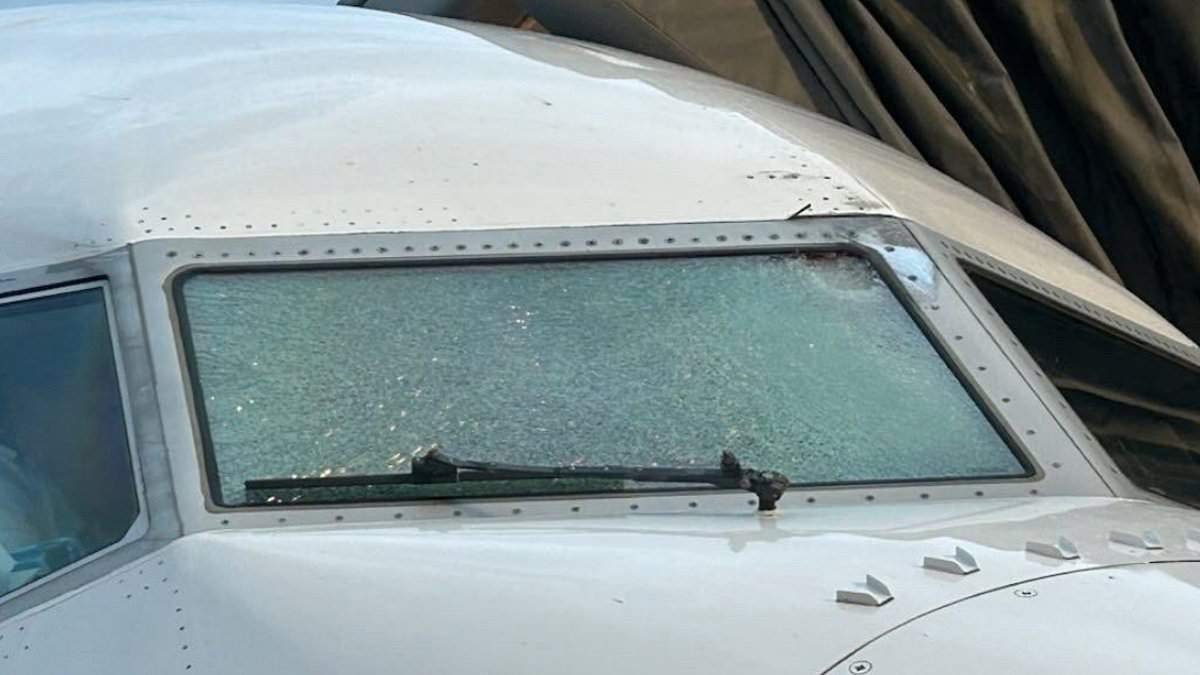Copyright dailymail

Aviation experts are warning that rogue weather balloons similar to one which shattered the windshield of a United Airlines plane could bring down other passenger jets. Dr. Hassan Shahidi, the president and CEO of the Flight Safety Foundation, called the incident involving Flight 1093 a 'serious accident' with the potential to happen again. The Los Angeles–bound plane was less than two hours into its journey from Denver, Colorado when its was forced to make an emergency landing last Thursday. The Boeing 737 Max 8 was struck at 36,000 feet by a foreign object which smashed its multi–layer windshield, spraying the cockpit with glass and slicing the pilot's arms. He was forced to divert the plane to Salt Lake City in Utah, saving the 134 passengers and six crew onboard. Matthew 'Whiz' Buckley, a former Navy fighter pilot who also has commercial flying experience with FedEx, said the situation would be a nightmare for any aviator. 'The worst case scenario is it does break, and if you're the one sitting in that seat, it could kill you. I mean, that shattered glass is like a hand grenade going off,' he told Daily Mail. 'And then if he or she isn't strapped in, and they're all the way up at altitude, they could get literally sucked out that window. And then they're gone. And now you have only one pilot left.' In this scenario, the entire cabin would rapidly depressurize, sending the oxygen masks down for passengers. 'When you're at cruising altitude – now, I don't want to give away all our secrets, but that's when the newspaper's out, or the iPad. Your feet are kicked up and you're relaxing,' Buckley said. 'To have that windshield crack like that, it's traumatic.' Buckley explained that the United Airlines pilot would have immediately begun descending to a lower, safer altitude to prevent the cabin from depressurizing before searching for a safe place to land. Another scenario to consider according to the experts, is if the weather balloon had hit one of the plane's engines. Shahidi explained that while aircraft manufacturers run simulations for bird strikes in engines, there has never been a need to test for errant weather balloons - because it was never thought of as a hazard until last week. Given that the allegedly offending weather balloon weighs around 2.4 pounds at launch and contains metal components, Shahidi concluded that a hypothetical engine strike from it could be catastrophic. ‘Yes, it could collide with the engine, and that's much more serious than a bird collision,’ he said. 'Birds, which are much smaller, can certainly bring an airplane down or take the engine out.' The cause of the impact remained a mystery until Monday, when WindBorne, a company that specializes in atmospheric forecasts released a statement saying that one of their roughly 2ft–long weather balloons was likely to blame. The National Transportation Safety Board (NTSB) is leading the investigation into what happened, but has not confirmed if the balloon was the object that hit the plane. Since WindBorne has the technology to pinpoint any one of their 100 balloons in the sky at a moment's notice, experts believe that the notoriously tight-lipped NTSB will eventually confirm that the balloon was the foreign object. The NTSB did not return a request for comment from the Daily Mail. Both Shahidi and Buckley said they were troubled over the fact that the weather balloon was ever in a position to hit the plane, since these devices are required to file aviation alerts, known as NOTAMs, to pilots and air traffic controllers every time they go up into the sky. They are also supposed to operate at altitudes of 60,000 to 120,000 feet to clear the typical cruising altitude for commercial airliners which is around 35,000ft. 'It is really of concern to see what is reportedly a weather balloon at that altitude collide with this aircraft going 500mph,' Shahidi said. 'Because of this collision, it resulted in the shattering of both the outer part of the windshield, as well as the inner part,' he added. 'These are highly–fortified windows that don't break easily.' Shahidi said the NTSB will look into whether NOTAMs were sent by the balloon operators or if the pilots received any such warning. 'The balloon should not have been in that airspace at the same time with the aircraft. So they will be looking at exactly the trajectory of the balloon,' Shahidi said. 'They'll certainly be looking at the flight plan of the airplane.' While strikes by weather balloons are rare, there are currently up to a hundred such devices in US airspace on any given day, spelling potential disaster for future flights. WindBorne has said it has already rolled out changes 'to minimize time spent between 30,000 and 40,000ft'. 'Additionally, we are further accelerating our plans to use live flight data to autonomously avoid planes, even if the planes are at a non–standard altitude,' the company said. Shahidi also questioned whether the balloon was under control at the time of the collision or if it was in free fall. 'There's a lot of traffic at 36,000ft, and if these balloons are going up and down, we want to make sure this never happens again,’ he said. Buckley also addressed a lot of the early speculation about what could have hit the United plane before WindBorne came out with a statement. Many people believed it had to have been debris from space or a satellite. 'Initially I thought that was more plausible, because I've never heard of a weather balloon getting hit by an airplane,' he said. Buckley pointed out that there are more satellites than ever, with nearly 12,000 in the atmosphere. A recent estimate from the National Oceanic and Atmospheric Administration found that the amount of satellite debris could 'rival the amount of naturally occurring meteor dust in the atmosphere by 2040'. 'Satellites outlive their usefulness. If they break or they're damaged or not responding, everything comes back down to earth,' Buckley said. 'Most of them burn up in the atmosphere...but there will be more incidences of space debris hitting airplanes.' Both experts are eager to hear the findings of the NTSB investigation, which typically take as long as two years to complete.



